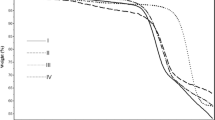Abstract
The pyrimidinodithiocarbamate polymer was prepared from the reaction of 2-mercapto-4,6-diaminopyrimidine with carbon disulfide, followed by condensation through the removal of H2S gas. Three polymer–metal complexes of cobalt, nickel, and copper were then prepared. The polymer and its complexes were investigated by elemental analyses, UV, IR, and magnetic susceptibility. The DC electrical conductivity variation, with the temperature in the region 298–498 K, of the polymer in its undoped and doped (5% iodine and 5% NiCl2) states and, also, of the three polymer complexes was determined. All the complexes showed an increase in conductivity with an increase in temperature in a semiconductor behavior. The thermal stability of the complexes was studied using the TGA technique. The structures of the polymer and its complexes were assigned. The proposed structure of the complexes is (MLX 2.mH2O)n. All the polymer complexes are thermally stable, are insoluble in common organic solvents, and have high melting points.
Similar content being viewed by others
REFERENCES
C. S. Marvel and N. Torkoy, J. Am. Chem. Soc. 79, 6000 (1957).
M. N. Patel and S. H. Patil, Synth. React. Inorg. Met.-Org. Chem. 13, 133 (1983).
J. E. Katon (ed.), Organic Semiconducting Polymers (Marcel Dekker, New York, 1968).
R. Riedere and W. Sawodny, Ang. Chem. 16, 859 (1977).
J. Hodghkin, Encyclopedia of Polymer Science and Engineering, 2nd ed. (John Wiley, New York, 1985). Vol. 3, p. 363.
W. E. Rudzinski, S. Gutherie, and P. Cassidy, J. Polym. Sci. Polym. Chem. 26, 1277 (1988).
Y. Saegosa, T. Takashima, and S. Nakamura, J. Polym. Sci. Polym. Chem. 30, 1375 (1992).
A. Bandish, J. F. Tinker, and G. B. Brown, J. Am. Chem. Soc. 70, 3109 (1948).
M. A. Abdalla and K. I. Ali, High Perf. Polym. 2, 235 (1990).
A. El-Shekeil, F. Al-Yusufy, and S. Saknidy, Polym. Int. 42, 39 (1997).
Fatma Al-Yusufy, M.S. thesis (Faculty of Science, Sana'a University, Yemen, 1995).
L. Shahada, A. El-Shekeil, and M. Mounir, J. Polym. Mater. 11, 211 (1994).
A. El-Shekeil, H. Al-Saady, and F. Al-Yusufy, New Polym. Mater. (1997), in press.
R. M. Silverstein, G. C. Bassler, and T. C. Morrill, Spectrometric Identification of Organic Compounds, 4th ed. (John Wiley, New York, 1970), pp. 159, 167, 214, 247.
A. El-Shekeil and A. El-Sonbati, Transit. Met. Chem. 17, 420 (1992).
K. Ueno and A. E. Marteil, J. Phys. Chem. 60, 1270 (1956).
J. R. Allan, A. D. Paton, K. Turvey, H. J. Bowley, and D. L. Gerrard, J. Coord Chem. 17, 255 (1988).
A. El-Shekeil and A. El-Sonbati, Makromol. Chem. 59, 319 (1992).
J. P. Fackler, Jr., F. A. Cotton, and D. W. Barnum, Inorg. Chem. 2, 79 (1966).
F. A. Cotton and J. J. Wise, J. Am. Chem. Soc. 88, 3451 (1966).
F. A. Cotton and J. J. Wise, Inorg. Chem. 6, 917 (1967).
W. E. Hatfield and T. S. Piper, Inorg. Chem. 3, 841 (1964).
A. G. Kanpidies and T. S. Piper, Inorg. Chem. 1, 970 (1962).
L. S. Forster and C. J. Ball Hausen, Acta Chem. Scand. 16, 1385 (1962).
Ali El-Shekeil and Fatma Al-Yusufy, Organic Conducting Polymers, presented at the First International Conference in Chemistry and its Applications, Qatar University, Doha, Qatar, Dec. 7–9 (1993).
H. S. Nalwa (ed.), Handbook of Organic Conductive Molecules and Polymers (John Wiley and Sons, Chichester, 1997), Vol. 2, p. 614.
A. Al-Dujaili, R. A. Shalash, and T. S. Yasagh, Eur. Polym. J. 29, 947 (1990).
M. Amin, A. El-Shekeil, M. Mounir, and M. Abu Elez, Angew. Makromol. Chem. 193, 13 (1991).
A. Tawansi, H. Zidan, Y. Moustafa, and A. Eldumiaty, Phys. Scripta 55, 243 (1997).
Author information
Authors and Affiliations
Rights and permissions
About this article
Cite this article
El-Shekeil, A., Almaidamah, H. & Al-Karbooly, A. Poly[4-Amino-2,6-pyrimidinodithiocarbamate] and Its Cobalt, Nickel, and Copper Complexes. Journal of Inorganic and Organometallic Polymers 7, 121–133 (1997). https://doi.org/10.1023/A:1021444328744
Issue Date:
DOI: https://doi.org/10.1023/A:1021444328744




